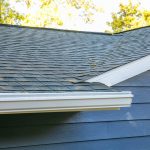
Gutters can last anywhere from 10 to 100 years, depending on the material, installation quality, and upkeep. Some gutter systems wear out within a decade, while others—like copper or zinc—can remain effective for a lifetime. Knowing when it’s time to replace your gutters helps protect your home from water damage.
So, how long do rain gutters last? The answer depends on the material, how well you clean your gutters, and whether they’ve been installed properly. Below is a breakdown of the average lifespan for the most common types of gutters on the market today.
Average lifespan of gutter materials
| Material | Average Lifespan |
| Aluminum | 20 to 30 years |
| Vinyl | 10 to 20 years |
| Seamless | 25 to 35 years |
| Copper | 50 to 100 years |
| Galvanized steel | 15 to 25 years |
| Galvalume | 30 to 40 years |
| Zinc | 80 to 100 years |
| Wood | 10 to 20 years |
GET GUTTERS THAT LAST
Upgrade to a durable, low-maintenance gutter system installed by local pros. Designed to protect your home season after season.
How long do aluminum gutters last?

Typical Lifespan
Aluminum gutters typically last 20 to 30 years, depending on maintenance and weather conditions. This lifespan assumes regular upkeep, but in the real world, clogged gutters, storm debris, and minor roof damage can shorten their performance. Still, they’re one of the most popular gutter options for homeowners seeking a durable gutter system.
What Improves Lifespan
You can extend the life of your gutters by keeping them clean, especially in the fall and spring. Installing gutter guards prevents debris buildup and reduces clogs. Using corrosion-resistant hangers and ensuring a proper slope away from your home’s roof will help water flow freely. Repainting can also protect against fading and corrosion.
Where does a drip edge go on a roof, and where is the correct placement for flashing? Knowing this can also help maintain a watertight system.
What Reduces Lifespan
Improper installation, pooling water, or sections that sag from roof pitch issues can cause early failure. Ice dams, heavy snow, or poorly sealed seams may lead to leaks. Aluminum won’t rust, but denting from hail or impact is a common issue in areas with rough weather.
Maintenance & Upkeep
Maintenance is moderate. Clean gutters every season and inspect for signs of gutter damage like leaks or detachment. Brackets may need to be tightened over time, and seams should be resealed as needed. An experienced gutter contractor can check alignment and recommend small fixes before major repairs are needed.
Cost Context
Aluminum gutters strike a balance between affordability and durability. They aren’t the cheapest on the market, but for a standard gutter system, they offer solid performance without the high cost of copper or zinc.
Ideal Use Cases
A strong choice for most residential homes. Ideal for modern new builds and replacements where the goal is low-maintenance, long-lasting results without overspending on materials. Aluminum is one of the most common types of gutter materials used for a reason—it works.
How long do vinyl gutters last?

Typical Lifespan
Vinyl gutters typically last 10 to 20 years. That estimate assumes cleanings are done regularly and that the gutter system is installed properly. In real-world conditions, exposure to UV rays and frequent freeze-thaw cycles can shorten that lifespan, especially if the roof and gutters aren’t working together efficiently.
What Improves Lifespan
To extend the life of your gutters, keep them free of debris and install gutter guards. Using UV-stabilized vinyl and ensuring proper slope away from the home can help prevent sagging or overflow. Quality brackets and fasteners make a difference, too.
What Reduces Lifespan
Harsh weather, ice dams, and poor installation are leading reasons why vinyl gutters fail early. Cracking is common, especially in areas with wide temperature swings. If you’re seeing warping or leaks, it may be time to replace it.
Maintenance & Upkeep
Upkeep is light but frequent. Clean gutters every season, inspect for cracks, and check fasteners for wear. Vinyl may warp under weight if left clogged, so gutter cleaning is critical.
Cost Context
Vinyl is among the most affordable gutter options, making it a practical choice for many homeowners, but it may require earlier replacement than metal styles.
Ideal Use Cases
A solid choice for budget installs or homeowners in mild climates who want quick and easy home improvement without a big investment.
How long do seamless gutters last?
Typical Lifespan
Seamless gutters usually last 25 to 35 years with proper care. Because they’re custom-fit and have fewer joints, they are less likely to leak or pull away from the home’s roof under pressure. This estimate reflects typical conditions, assuming seasonal maintenance.
What Improves Lifespan
Having seamless gutters installed by a professional gutter contractor ensures proper pitch and drainage. Gutter guards, correct spacing, and regular debris removal all help extend durability.
What Reduces Lifespan
Improper slope, sagging gutters, or clogged downspouts can lead to water backup and premature wear. If sections overflow or show signs of gutter damage, it may be time to act.
Maintenance & Upkeep
Moderate upkeep is needed. Check seams at corners, clean twice a year, and reseal any disconnected joints to keep water flowing away from your home.
Cost Context
More expensive than standard sectional systems, but you get stronger performance, better aesthetics, and fewer long-term repairs.
Ideal Use Cases
Great for modern new builds or replacements when homeowners want effective gutter performance without visible seams.
Extend the life of your roof and foundation with high-quality gutter replacements built to handle Wisconsin’s weather.
How long do copper gutters last?
Typical Lifespan
Copper gutters can last 50 to 100 years, even in challenging climates. This long lifespan assumes the gutters are cleaned and maintained periodically, especially at seams and joints. With time, they form a patina that protects them naturally.
What Improves Lifespan
Copper gutters benefit from seasonal cleanouts, high-quality soldering, and compatible hangers. Removing excess debris and checking for leaks will help them perform better over time.
What Reduces Lifespan
Salt air, incorrect fasteners, or pooling water can wear on the system over time. Though copper is durable, improper care or mixing metal types may lead to corrosion or gutter damage.
Maintenance & Upkeep
Maintenance is moderate. There’s no need to repaint, but some homeowners clean the patina for aesthetics. Check joints and ensure your home is free of tree branches that could dent the surface.
Cost Context
Copper costs more upfront, but since copper gutters can last for decades—often longer than the home’s roof—they deliver strong long-term value.
Ideal Use Cases
Perfect for historic homes or high-end builds where looks and longevity are both priorities.
How long do galvanized steel gutters last?
Typical Lifespan
Galvanized steel gutters last around 15 to 25 years. They’re strong and weather-resistant, but their actual lifespan depends on maintenance and exposure. Rust can appear earlier in harsh environments, especially if gutters are left full of debris.
What Improves Lifespan
Repainting exposed areas, sealing seams, and keeping water flowing are all important steps. Use rust-resistant hangers and check gutters every season to ensure they’re working properly.
What Reduces Lifespan
Salt air, pooling water, and poor gutter installation reduce the lifespan quickly. Gutters might also rust faster if scratches or dents aren’t treated right away.
Maintenance & Upkeep
Moderate to high. Repainting, checking brackets, and removing rust patches will help prevent bigger problems. You’ll also need to monitor joints for leaks.
Cost Context
These gutters offer strong performance at a lower price than copper or zinc, but need more attention to stay in good condition.
Ideal Use Cases
Best for areas without coastal exposure. A good fit for homeowners looking for strength and affordability in one system.
Contact our experts at your earliest convenience for tailored advice and solutions for your home!
How long do Galvalume gutters last?
Typical Lifespan
Galvalume gutters usually last 30 to 40 years. Their aluminum-zinc coating makes them more corrosion-resistant than standard steel options. This range reflects real-life wear and tear when cleaned and checked consistently.
What Improves Lifespan
Routine maintenance, professional installation, and avoiding dissimilar metal contact are key. Good roof pitch and clear downspouts help water away from your home, preserving gutter strength.
What Reduces Lifespan
Scratched or cut edges that expose raw metal can rust over time. Lack of gutter cleaning allows moisture to sit, accelerating wear and reducing overall performance.
Maintenance & Upkeep
Low to moderate. Galvalume doesn’t require painting, but it should still be inspected twice a year. Check for dents, loose fasteners, and pooling water.
Cost Context
A great middle-ground for homeowners who want a longer life than galvanized steel without the price tag of copper.
Ideal Use Cases
Strong choice for homes in wet or snowy areas where gutter longevity matters and maintenance time is limited.
How long do zinc gutters last?
Typical Lifespan
Zinc gutters last between 80 and 100 years. They develop a protective layer over time, making them one of the most effective gutter options available. This lifespan assumes professional installation and basic seasonal care.
What Improves Lifespan
Zinc works best when combined with matching fasteners and installed with a proper slope. Keep your gutters clear of debris and use guards to prevent overflow.
What Reduces Lifespan
Incompatible metal contact, lack of cleaning, or physical damage from snow or tree limbs can shorten their effectiveness. Know when to replace gutters by watching for signs of separation or leaks near the seams.
Maintenance & Upkeep
Very low. No painting needed, and natural patina protects against corrosion. Remove debris and check for damage twice a year.
Cost Context
Zinc is more expensive than aluminum or vinyl, but since gutters are an essential part of protecting your home, the cost can be worth it for decades of reliability.
Ideal Use Cases
Zinc works well on custom homes, historic restorations, and long-term residences where replacement is not ideal.
How long do wood gutters last?
Typical Lifespan
Wood gutters last about 10 to 20 years, depending on the material and upkeep. They require careful sealing and frequent inspection. While they were once a standard gutter option, they’re now mostly used for historic or architectural reasons.
What Improves Lifespan
To extend the life of your gutters, reseal them every few years, keep downspouts clear, and install leaf guards. Avoid standing water and protect the finish from mildew or rot.
What Reduces Lifespan
Lack of maintenance, blocked drains, and constant moisture exposure will damage the wood quickly. You’ll know if it’s time to replace it when leaks or splits appear.
Maintenance & Upkeep
High. You’ll need to reseal, repaint, and inspect these gutters often. Structural integrity can fail without regular care.
Cost Context
Less expensive to install than copper, but expensive to maintain. The cost over time can be high due to the labor involved.
Ideal Use Cases
Best for historic homes where visual accuracy matters. When choosing the right gutter for restoration projects, wood is still a valid option.
HIGH-QUALITY
ROOF REPLACEMENT
YOU CAN RELY ON
Choose Prairie Exteriors for durable, dependable asphalt roofing solutions designed to stand the test of time.
A table showing how long gutters last
So, how long should gutters last on your home? The table below breaks down the expected lifespan of various gutter materials and what factors might influence their durability.
| Gutter Type | Expected Lifespan | Notes |
| Aluminum | 20–30 years | Most common, lightweight, and rust-resistant |
| Vinyl | 10–20 years | Affordable but prone to cracking in extreme temps |
| Seamless Aluminum | 25–30 years | Fewer leaks due to a lack of seams |
| Copper | 50+ years | Highly durable and decorative; expensive |
| Galvanized Steel | 15–20 years | Strong but can rust if the coating wears off |
| Galvalume | 20–25 years | Steel with aluminum-zinc coating for extra corrosion resistance |
| Zinc | 80–100 years | Premium option, naturally corrosion-resistant |
| Wood (Cedar/Redwood) | 20–50 years | Used in historic homes; requires high maintenance |
Key takeaways on gutter lifespan
Gutters play a major role in protecting your home from water damage, but their lifespan depends on the material, installation quality, and regular upkeep. Whether you’re dealing with clogged gutters, sagging sections, or signs of wear, knowing when to replace gutters can save you time and money in the long run.
If you’re not sure what type of system is best our team is ready to help. Reach out today for expert gutter advice and service across Dane County.



